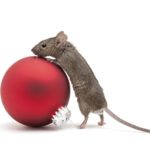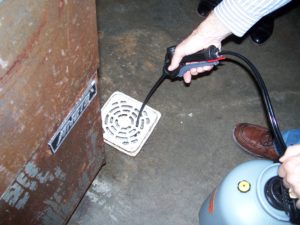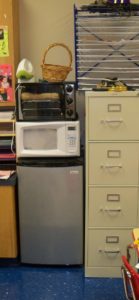 It is that time of year. It’s time to clean out the classroom and get ready for the holiday break. Before you take some time to be with family and just relax, let’s take some time to think about sanitation. When you close up the classroom, make sure that you don’t leave behind a picnic for pests.
It is that time of year. It’s time to clean out the classroom and get ready for the holiday break. Before you take some time to be with family and just relax, let’s take some time to think about sanitation. When you close up the classroom, make sure that you don’t leave behind a picnic for pests.
The pests we generally see in schools include cockroaches, mice, rats, spiders, ants, silverfish, and occasionally crickets. These pests are animals and they like the same things we do, food, water, harborage and safety. The holiday break is a perfect time for pests to thrive because we often forget and leave something behind to live on.
Places that provide the necessities for pest survival are what we term pest vulnerable areas (PVA). Each of these areas should be thoroughly inspected before leaving for winter break. Areas that need special attention include the kitchen and cafeteria, faculty lounge, custodial storage areas, science classrooms, art centers, special needs classrooms, kindergarten and daycare classrooms, locker rooms, culinary arts/home economics classrooms and other reported pest “hot spots.”

Remember all floor drains can become pest vulnerable areas.
The kitchen and cafeteria will require some deep cleaning. Floor drains should be inspected for organic matter build up, for those drains that are filthy, look for microbial and enzyme scum digesters to help reduce this build up. At the same time, all equipment and floors, especially corners and around furniture legs, should be degreased. Don’t forget that walls and light fixtures should also be cleaned. Just a small amount of food, grease, splatter or other organic material can allow pests to thrive while no one is around to watch.
In the teacher’s lounge, check refrigerator seals, clean inside and under the microwave, behind and around soda machines and under sinks. These are excellent places to harbor pests. Also, be sure to clean any pest droppings you find. Droppings are difficult to age, and the pest manager won’t be able to conclude whether the infestation is old or new, unless they know that the area has been thoroughly cleaned.
How about classrooms? Clutter, candy and improper storage are a pests best hiding place and feeding station. Upholstered furniture is a pest haven. By reducing clutter, the jobs of the sanitarian and the pest manager become easier.
Remind custodial and other staff members that if they come across any live pests while cleaning, be sure to record what type and where on the pest sighting log or work order system. This is a good time to remind everyone that proper documentation of what they see helps you and the IPM program solve the problem before it becomes newsworthy.
How do you minimize a PVA?
- Reduce pest entry
- Repair cracks, holes, and gaps
- Reduce food sources
- Store food, even pet food, in sealable containers
- Clean, clean, clean
- Reduce harborage
- Eliminate clutter and cardboard
Refrigerators, microwaves, and toasters.

Locate every microwave and fridge to insure nothing surprises you in January.
Remember, pests only need crumbs or food residue (especially greasy surfaces) to survive for months. If these areas are not thoroughly and regularly cleaned, your pest manager will have a difficult time managing the pests. Also, if there is an infestation that must be treated, the food stuffs compete with the bait treatment, making it ineffective. This is a lose lose situation. What is left is an unsanitary area that still has a pest problem. If your school has problem areas like these, determine who is responsible for cleaning that area and set a regular cleaning schedule. In areas like these, there is often upholstered furniture. Don’t forget that the furniture needs to be vacuumed as you are cleaning the room. The cracks and crevices hold crumbs and can be home to cockroaches, silverfish and rodents. Sanitation is a group effort and once if maintained, is a crucial part of pest management.
One of the best ways to document what you see is to utilize an IPM Inspection form. Remember good documentation can help you answer questions to school administrators, parents, teachers and any one else who asks. Check out this Inspection_Checklist_for_School_Facility created by NC State University.
Finally, don’t forget about mold and mildew.
Mold and mildew often happens by the fluctuations in temperatures and humidity during shut-downs. This can happen anywhere on campus but one area that is forgotten is Athletic and Band Hall areas due to items that are put into storage moist or left after an event. Remember these area areas that should be part of your continuous monitoring of indoor humidity along with known problem areas.
5 steps to minimize mold risk during & after a shutdown:
- Maintain indoor humidity as low as possible, not exceeding 50%, as measured with a humidity meter
- After a prolonged shutdown and before occupants return, buildings should be assessed for mold and excess moisture
- After an assessment has confirmed that mold and moisture are not detected OR after remediation has been completed, a building HVAC system that has not been active during a prolonged shutdown should be operated for at least 48 to 72 hours (known as a “flush out” period) before occupants return
- Open air to the highest setting that allows you to maintain desired indoor air temp
- Flush till odors are removed
- Check HVAC filters-they may need to be changed after flush out
- After a building is reopened and occupied, routine (e.g., weekly) checks of the HVAC system are recommended to ensure operating efficiency
- If no routine HVAC operation and maintenance program is in place for the building, one should be developed and implemented
At a minimum, consider:- Inspection and maintenance of HVAC components
- Calibration of HVAC system controls
- HVAC testing and balancing
Visit the CDC/National Institute for Occupational Safety and Health [NIOSH] for more information controlling dampness issues that result in indoor mold growth, as well as on renovation and remediation if indoor mold has become an issue. Check out their Dampness and Mold Assessment Tool for Schools and General Buildings
And thank you to TASB Facility Services and Risk Management Fund for the information about mold and mildew.

 .
.